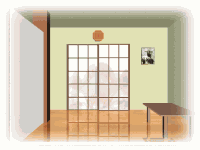

Housing
Apartments are described by LDK and not square metres. LDK = Living room, Dining area and Kitchen. Therefore a 2DK has two rooms and a dining area/kitchen combined. A 1K has one room and a small kitchen. These apartments may sometimes be described as a "one-room." A 3LDK has three rooms with a large combined living/dining area/kitchen.
Japanese apartments may be a combination of both washitsu (Japanese style rooms) and yoshitsu (Western style rooms). The floor area of washitsu is measured in tatami mats, i.e. rooms are "6 mats," "8 mats," etc. The average size of a tatami mat is 2 metres by 1 metre.
The genkan (entrance) is considered public space so if you do not want people walkng in, keep the door locked. It is in the genkan you must take off your shoes and from there walk into the apartment, only wearing your socks. Sometimes people will provide a pair of slippers for you to wear.
It is a custom to give presents to neighbours when moving into a new dwelling. This gift is often in the form of hand towels.
To begin a new rental on an apartment, tenants usually pay one month’s rent in advance, a premium (kenrikin), key money (reikin), and a deposit (shikikin).
The kenrikin is basically for signing the rental contract and is usually equivalent to one month’s rent. This is non-refundable. You can ask to have this charge removed from your rental contract as there is no law that stipulates tenants have to pay kenrikin. However, many people renting housing end up paying this fee.
The reikin is a gratuity payment to the landlord. This can often be in the range of two month’s rent. This is non-refundable.
The shikikin is used to cover damage to the apartment. The deposit SHOULD NOT pay for normal wear and tear of things, such as tatami. Shikikin is refundable. The cost of the deposit may be around two month’s rent.
There exists yet another hefty charge called koshinryo. This is similar to kenrikin above but has to be paid when tenants renew their contract after two years. Again it is usually equivalent to one month’s rent and is non-refundable. Once again there is no law that stipulates tenants have to pay koshinryo.
Combined costs of key money and deposit can cost anywhere from Y400,000 for a 2DK near Sayama Station, to around Y245,000 for a 3DK near the Central Post Office. However, as the housing market softens, the amount of the above fees will inevitably become lower. Municipal housing (subsidised by the city) are cheaper, but are not available for non-Japanese.
A guarantor is also required if you want to secure an apartment. This person/body guarantees that if you do not pay your rent, they will.
While the above may seem like a huge amount to pay in advance, landlords see this system as a kind of credit check, to ensure they receive their rent. Many however, including Japanese, may see the fees as excessive.
It is sobering to remember that Japanese people must also go through ALL the above to secure an apartment for themselves.
As a post script, there is yet another fee to pay! Jichikaihi is a monthly association fee for living in an apartment. This may be as little as Y2,000.
Home - Daily Life - Shopping - Japanese Language - Culture - Recreation - Medical Information - The Telephone - Things Foreign - Visa Information - Leaving - Chinese Zodiac